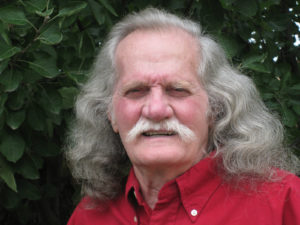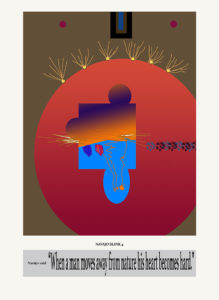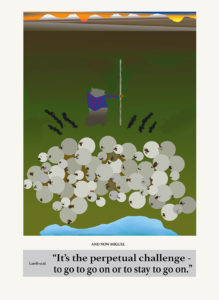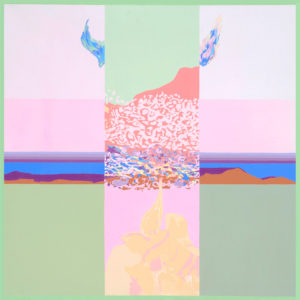 An accomplished and prolific artist, Jim Gilbert is a native-born New Mexican. He created his latest series, 36 works entitled “Homage to New Mexico” (his physical and spiritual home), during a recent four-month stay in NYC. This collection is currently showing at Ennui Gallery in Taos for the month of June. It is a celebration of New Mexico and its great diversity.
An accomplished and prolific artist, Jim Gilbert is a native-born New Mexican. He created his latest series, 36 works entitled “Homage to New Mexico” (his physical and spiritual home), during a recent four-month stay in NYC. This collection is currently showing at Ennui Gallery in Taos for the month of June. It is a celebration of New Mexico and its great diversity.
Gulcin: This show marks the first in a series of shows you are doing in Taos. Please tell us a little about them.
Jim: It’s something that I’m very happy to do because it’s the first time in many years that I’ve done any showings of my work. I’ve stayed away from putting my works out because I really needed the time to explore multiple dimensions of my own interests. I simply needed the space for myself. As with everything, there is a time for things to happen and now I really welcome the opportunity to exhibit some of the work that I’ve been involved in during the past few years.
I have a very nice opportunity to show a series of my work, “Homage to New Mexico,” at the Ennui Gallery on Bent Street in Taos in June and July. These were pieces that I produced over the winter while I was in New York.
I’ll also be showing a few of my larger paintings in the Taos Mesa Brewing Tap Room in downtown Taos over the entire summer. In the fall, I’m planning a retrospective of my works at a space TBD.
Gulcin: What media do you work with?
Jim: I’ve been involved with doing thematic series. Some are pen-and-ink drawings and some are paintings and giclee prints. They vary in size. The works shown at the Ennui gallery are giclees, which I created using Photoshop. There are 36 images in the “Homage to New Mexico series. The images in this show are roughly 8 1/2×13” prints.
Gulcin: What was your process in creating “Homage to New Mexico?”
Jim: I decided in doing this project that I wouldn’t intellectualize but just choose things that occurred to me. Many are based on events that I experienced in childhood or that I just had general feelings about, which reflect my relationship with this wonderful state of New Mexico.
For example, there’s one image reflecting the kind of rough frontier life that I experienced growing up. It was the end of both the frontier time and the cowboys and Indians era.
Another neat part of the show is a mini-series that was based on the chorus of the state song, “O Fair New Mexico.” It was written in 1915 by Elizabeth Garrett, the blind daughter of Sheriff Pat Garrett, who shot Billy the Kid.
The inspiration for some of the works is based on historical events such as the wonderful film called, “…And Now Miguel,” which was done in 1953. It is a documentary that was done by the United State government. This federal project portrays a young 14-year-old boy who is just coming of age and is about his life as a sheep herder finding his place in the Hispanic tradition of the agricultural and ranching life. It’s a touching story.
Gulcin: What are some of the other themes?
Jim: There’s a mini-series within this group that has to do with six Navajo sayings that I like very much. They are quite profound. I call the series, Navajo Blink.
The inspiration came from when I was very, very young. We lived in the Farmington area, in the Navajo reservation area where my father was building Route 66. And even before being involved with the construction of Route 66, he was involved with surveying the area. As such, we traveled a lot in that region. There was simply a natural affinity with the Navajo. It wasn’t like “those” Indians. They were just people that we knew and they were our friends. They were people that had a restricted area as a culture and as a nation, where they could live. I had a sense of their spirit, that it was so much less of a competitive, commodity-driven kind of existence. I couldn’t express it that way as a child, but it was something that impressed me. It was simply that they had a different attitude about living. It was a quiet, more gentle kind of relationship with each other and the land.
Most of the inspiration for other images besides the Navajo and the State Song series are individual experiences or individual relationships between me and something that was very poignant in my memory. Not everything was happy or great. Some of the memories were of tough stuff. Growing up in remote places meant a very hard, rigorous life. We once spent six to eight months in Newkirk, New Mexico. My father built a bridge there. This was when I was about ten years old, about 1939. I remember life was really hard in Newkirk. I’ll never forget the look of desperation on men’s faces there during the depression. We also faced constant exposure to the weather. Having indoor plumbing was out of the question. For me it was walking to school for a mile in winter in the cold and snow. It was hard but there were also times that it was a lot of fun for us kids.
Gulcin: What were some of the other experiences that influenced you?
Jim: Some of the experiences have to do with being a child during the Second World War. During this period, we were in Alamogordo and my father was building runways at Holloman AFB. One morning we heard this loud thunderous noise. We were told that it was 2,000 tons of TNT that blew up. What really happened was that it was the first atomic bomb, set off at the Trinity site.* It made a deep impression on me, even as a child. You couldn’t not be impressed with something like that, especially after learning about the first atomic bomb dropped on Hiroshima. That was when the secret of what was going on in Los Alamos came out and we learned that was where they constructed the atom bomb. That blast marked the beginning of the atomic age.
Gulcin: Was that the first time that you heard about what it actually was?
Jim: Yes. It was the first time that practically anybody did. It was a super-secret. I remember a lot of speculation about what was going on in Los Alamos in the ’40s and one theory was that they were building a submarine base and a channel from, I think, Houston to Los Alamos. It was such a secret site, and understandably so. Anyway, all that cover-up combined with that particular site and the second World War going on, created deep impressions on everybody who was living at the time.
Gulcin: There probably aren’t too many people who actually heard that very first blast.
Jim: I guess not. It was a surprise for everyone. If you had been in that approximate 60-mile radius, you would have heard it.
Gulcin: And the State song, did that choice also come from your childhood?
Jim: As with any of the choices of the themes, it just suddenly was there for me to do. I didn’t sit down and try to outline the different things. I did it differently. I just said, “what are things that are near and dear to me or events that impressed me, that were intrinsic to New Mexico.” I let it come that way rather than outline and plan. I would do a work and have no idea what the next one would be. Then within a day or two I would realize what it would be. Thinking, well ok, there was that time in Newkirk that inspired something or hearing the boom of what Los Alamos had created at the Trinity site.
Some of the images also have to do with my feeling toward the state and hopes for directions that it can go. I put these in more of a poetic framework rather than making a portrait of an event. It’s based on intuition, feelings and something that Winnie the Pooh was very good at; you want to create a poem, you start and then you just let it happen. That’s the way that my work very often, goes.
For instance, there’s one image I call, “The Dukes.” The Dukes come from the nickname of Albuquerque, Duke City. One day I was just thinking about a baseball team called “The Dukes” and then I was considering the many transitions Albuquerque has gone through. The image relates to these transitions and a hope for a positive evolution for Albuquerque.
Gulcin: Was there anything specific that inspired you from the current time?
Jim: One of the things that I hint at, is the hope that we don’t let blind economic development overshadow the true, more basic sense of life, and the importance of life. And I’m not putting down economic development. I think this is something that is critical to survival. The problem that we are very often faced with, however, not only globally, but in terms of our local area, is that economic development is often produced by a formula and it creates a landscape of here, there and everywhere else too. It destroys local character. It’s a one-dimensional approach to economics which is very, very poor economics. I’ve kind of hinted at that kind of thing in my series, but again, I didn’t do this work so much as an exposé of ideas, but mainly paying homage to a wonderful state.
Gulcin: And the words you wrote under the images, did they come before or after you created the images?
Jim: The Navajo sayings are known sayings from the Navajo. The words to the chorus of, “O Fair New Mexico,” were written by Elizabeth Garrett. But the rest are words that I developed. The words sometimes came first. Sometimes they came after. It’s kind of like a good meal, do you want to have an hors d’oeuvre first or do you want to have a bowl of soup? It was all right there, it was just a matter of pulling them up in a sequence.
Gulcin: How long did this series take to produce?
Jim: Four months.
Gulcin: And you produced them while you were in New York?
Jim: I produced everything in New York. It was a great opportunity to have time with family and also have the space to produce these works.
Gulcin: And the idea for it came to you in New York, or before?
Jim: It came in New York. It just suddenly was there.
Gulcin: Anything you’d like to add about the series and showing it in Taos.
Jim: I’m very happy about it. When I look at the work I feel very good about it. It’s a continuation of a direction that I began, more consciously, about seven or eight years ago.
I’m also very interested in expanding the realm of “art,” so to speak, and moving it into the realm of experience. I recently saw a wonderful film called, “The Cave of Forgotten Dreams,” by Werner Herzog. It deals with this cave in France, that was recently discovered. The images inside are around 30,000 years old, much older than the Lascaux paintings, which were thought to be the oldest ones. They were estimated to be around 17,000 years old. In looking at the work, the portrayal of the animals is as good as practically any artist could do today. Magnificent images of mostly animals and the life at the time. I thought, this was not done by people who were “artists” or having grants or famous or anything like that. They were undoubtedly very simple people who were just involved in some kind of a portrayal or representation of the world around them. The purpose for the drawings may have been religious or perhaps just to better communicate. There is a purity in these cave drawings. It made me realize that we have so much raw commercialism in all fields today. The arts yes, but also education, health, medicine, news, what have you. This tends to overshadow the intrinsic value of these works. My hope is that in my current series of artworks, the viewer can have a relationship with them rather than just looking at them and saying, “oh my, what a wonderful artist that is and maybe I can have that for my collection.” Which is all OK too, but it can be nice to have a space where a more profound experience is possible.
I’m very excited about this show and welcome all to enjoy “Homage to New Mexico.”
* Jornada del Muerto, was the original name of the location for the first detonation of a nuclear weapon at 5:29 a.m. on July 16, 1945 as part of the Manhattan Project; yield, 20 kilotons of TNT. The name of the site has henceforth been known as The Trinity site.



